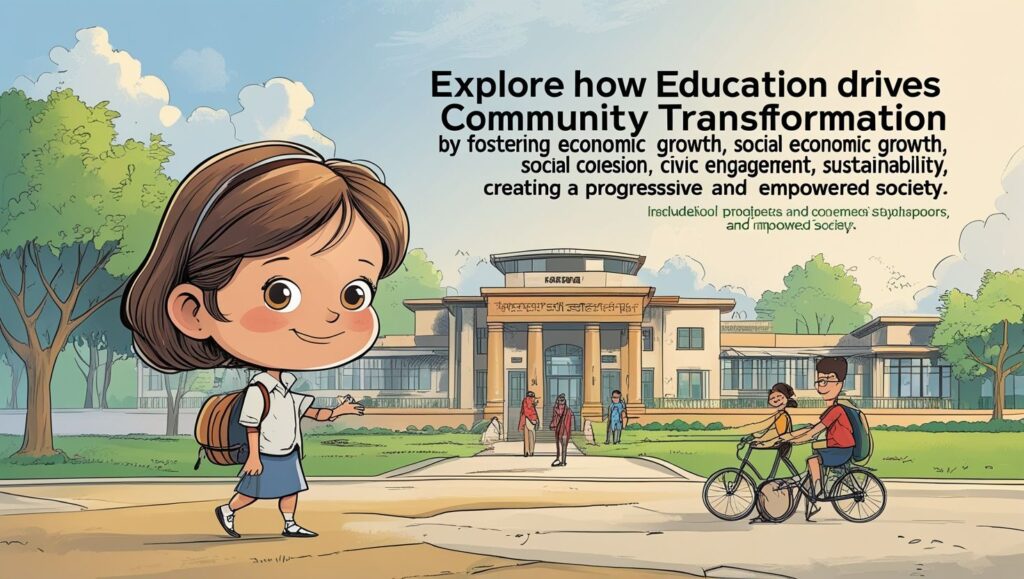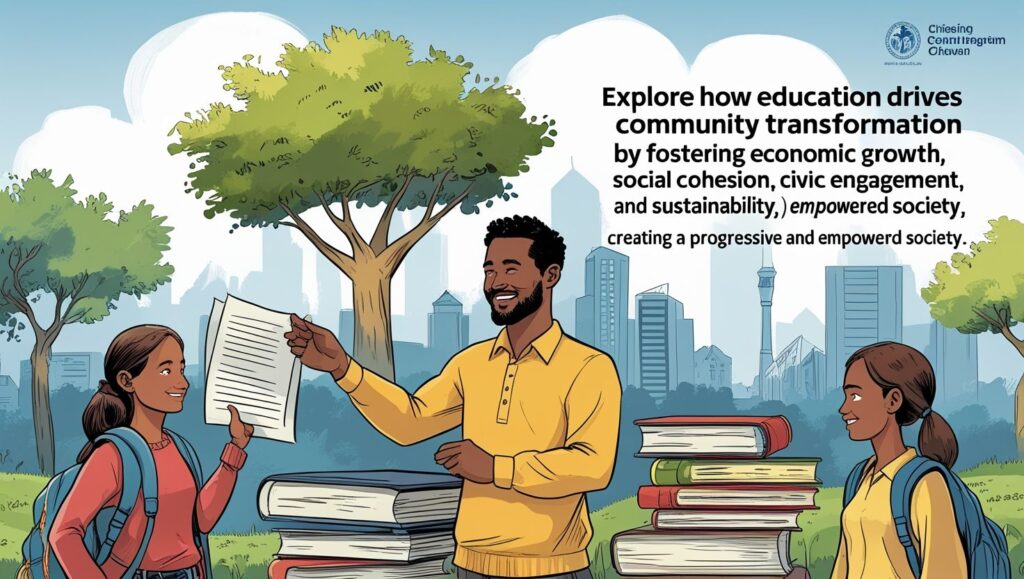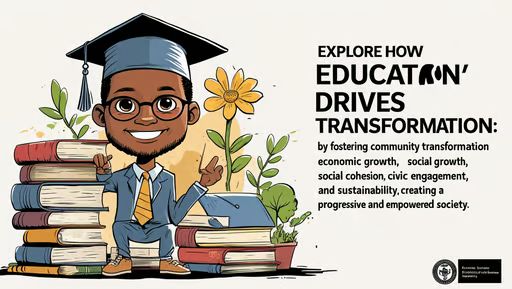Transformation of Community Through Education, Education is often hailed as the cornerstone of societal development and individual empowerment. It is a powerful tool that can transform communities by breaking the cycle of poverty, fostering economic growth, promoting social equality, and nurturing informed and engaged citizens. The transformative power of education extends beyond individual benefits; it has the potential to uplift entire communities, creating a ripple effect that impacts future generations. This article explores how education serves as a catalyst for community transformation, the challenges faced in achieving this goal, and strategies to harness education for sustainable development.
The Role of Education in Community Transformation
Education is more than just the acquisition of knowledge; it is a means of empowering individuals to think critically, solve problems, and contribute meaningfully to society. When communities prioritize education, they lay the foundation for holistic development. Here are some key ways in which education transforms communities:
1. Economic Empowerment
Education equips individuals with the skills and knowledge needed to secure better job opportunities, start businesses, and contribute to the local economy. An educated workforce attracts investment, drives innovation, and reduces unemployment. For example, communities with higher literacy rates often experience faster economic growth and improved living standards.
2. Social Equality and Inclusion
Education promotes social equality by providing marginalized groups, including women, minorities, and individuals with disabilities, access to opportunities. It challenges stereotypes, reduces discrimination, and fosters a culture of inclusivity. Educated communities are more likely to advocate for their rights and participate in decision-making processes.
3. Health and Well-being
Education is closely linked to improved health outcomes. Educated individuals are more likely to make informed decisions about nutrition, hygiene, and healthcare. They are also better equipped to prevent diseases and access medical services. For instance, maternal and child mortality rates are significantly lower in communities with higher levels of education.
4. Civic Engagement and Democracy
Education fosters civic responsibility and active participation in democratic processes. Educated citizens are more likely to vote, engage in community development initiatives, and hold leaders accountable. This strengthens governance and promotes transparency and accountability.
5. Cultural Preservation and Innovation
Education helps communities preserve their cultural heritage while embracing innovation. It encourages critical thinking and creativity, enabling communities to adapt to changing circumstances without losing their identity.

Challenges in Transforming Communities Through Education
Despite its transformative potential, education faces numerous challenges that hinder its ability to drive community development. These challenges include:
1. Access to Quality Education
Many communities, particularly in rural and underserved areas, lack access to quality education. Factors such as poverty, inadequate infrastructure, and teacher shortages contribute to low enrollment and high dropout rates.
2. Gender Disparities
In many parts of the world, girls and women face barriers to education due to cultural norms, early marriages, and lack of safety. This perpetuates gender inequality and limits the potential of half the population.
3. Resource Constraints
Limited funding, outdated curricula, and insufficient teaching materials often compromise the quality of education. This is especially true in developing countries where education budgets are stretched thin.
4. Conflict and Displacement
Communities affected by conflict or natural disasters often experience disruptions in education. Displaced children and youth are particularly vulnerable, as they may lack access to schools or face trauma that hinders learning.
5. Relevance of Education
In some cases, education systems fail to address the specific needs of communities. Curricula that are not aligned with local contexts or labor market demands can lead to unemployment and underemployment.
Strategies for Harnessing Education for Community Transformation
To overcome these challenges and maximize the impact of education, communities, governments, and organizations must adopt targeted strategies. Here are some effective approaches:
1. Investing in Early Childhood Education
Early childhood education lays the foundation for lifelong learning and development. By investing in preschool programs, communities can ensure that children enter primary school ready to learn and succeed.
2. Promoting Gender Equality in Education
Efforts to eliminate gender disparities in education must address cultural, economic, and safety-related barriers. Scholarships, mentorship programs, and community awareness campaigns can encourage girls to stay in school.
3. Improving Infrastructure and Resources
Governments and organizations should prioritize building schools, providing clean water and sanitation facilities, and equipping classrooms with modern teaching tools. This creates a conducive learning environment for students.
4. Teacher Training and Support
Teachers play a critical role in delivering quality education. Providing ongoing training, fair wages, and professional development opportunities can enhance their effectiveness and motivation.
5. Community Involvement
Engaging parents, local leaders, and community members in education initiatives fosters a sense of ownership and accountability. Community-led programs are more likely to address local needs and gain widespread support.
6. Leveraging Technology
Technology can bridge gaps in access to education, especially in remote areas. Online learning platforms, digital libraries, and mobile apps can provide students with access to quality resources and interactive learning experiences.
7. Tailoring Education to Local Needs
Education systems should be designed to reflect the cultural, social, and economic realities of the community. Vocational training, entrepreneurship programs, and curricula that emphasize critical thinking and problem-solving can prepare students for real-world challenges.
8. Addressing Conflict and Displacement
In conflict-affected areas, education must be prioritized as a tool for healing and rebuilding. Temporary learning spaces, psychosocial support, and inclusive policies can help displaced children continue their education.

Success Stories: Education Transforming Communities
Several examples from around the world demonstrate the transformative power of education:
1. Kerala, India
Kerala, a state in India, has achieved near-universal literacy through a strong emphasis on education. The state’s investment in public schools, teacher training, and community involvement has resulted in improved health outcomes, reduced poverty, and a thriving economy.
2. Finland’s Education Model
Finland’s education system, known for its emphasis on equality and innovation, has consistently ranked among the best in the world. By focusing on teacher quality, student well-being, and a flexible curriculum, Finland has created a model that other countries aspire to replicate.
3. BRAC’s Non-Formal Education Program
BRAC, a development organization in Bangladesh, has transformed the lives of millions through its non-formal education program. By targeting out-of-school children, particularly girls, BRAC has increased enrollment rates and improved learning outcomes in underserved communities.
4. Rwanda’s Post-Genocide Recovery
Following the 1994 genocide, Rwanda prioritized education as a means of rebuilding the nation. The government’s focus on universal primary education, gender equality, and vocational training has contributed to the country’s remarkable recovery and development.
The Way Forward
The transformation of communities through education is not a one-time effort but an ongoing process that requires commitment, collaboration, and innovation. Governments, non-governmental organizations, private sector actors, and communities must work together to address the barriers to education and create inclusive, equitable, and sustainable systems.
Education is not just a fundamental human right; it is a powerful force for change. By investing in education, we invest in the future of individuals, communities, and nations. As Nelson Mandela famously said, “Education is the most powerful weapon which you can use to change the world.” Let us harness this weapon to build a brighter, more equitable, and prosperous future for all.
Conclusion
Education is the key to unlocking the potential of individuals and communities. It empowers people to overcome poverty, inequality, and injustice, paving the way for sustainable development. While challenges remain, the success stories from around the world prove that transformative change is possible. By prioritizing education, fostering collaboration, and addressing systemic barriers, we can create a world where every individual has the opportunity to learn, grow, and thrive. The transformation of communities through education is not just a dream; it is a tangible goal that we must strive to achieve.

3 thoughts on “Transformation of Community Through Education”
Comments are closed.